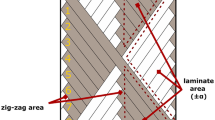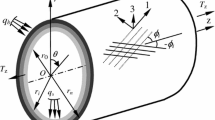Abstract
An optimization procedure is developed for obtaining optimal structural design of filament wound composite pipes with minimum cost utilized in pressurized water and waste-water pipelines. First, the short-term and long-term design constraints dictated by international standards are identified. Then, proper computational tools are developed for predicting the structural properties of the composite pipes based on the design architecture of layers. The developed computational tools are validated by relying on experimental analysis. Then, an integrated design-optimization process is developed to minimize the price as the main objective, taking into account design requirements and manufacturing limitations as the constraints and treating lay-up sequence, fiber volume fraction, winding angle, and the number of total layers as design variables. The developed method is implemented in various case studies, and the results are presented and discussed.
Similar content being viewed by others
References
Nikbakt S, Kamarian S, Shakeri M. A review on optimization of composite structures Part I: Laminated composites. Composite Structures, 2018, 195: 158–185
Pan G, Lu J, Shen K, Ke J. Optimization of composite cylindrical shell subjected to hydrostatic pressure. In: International Conference on Intelligent Robotics and Applications. Cham: Springer, 2015, 81–90
Smerdov A A. A computational study in optimum formulations of optimization problems on laminated cylindrical shells for buckling I. Shells under axial compression. Composites Science and Technology, 2000, 60(11): 2057–2066
Diaconu C G, Sato M, Sekine H. Buckling characteristics and layup optimization of long laminated composite cylindrical shells subjected to combined loads using lamination parameters. Composite Structures, 2002, 58(4): 423–433
Foldager J P, Hansen J S, Olhoff N. Optimization of the buckling load for composite structures taking thermal effects into account. Structural and Multidisciplinary Optimization, 2001, 21(1): 14–31
Irisarri F X, Abdalla M M, Gürdal Z. Improved Shepard’s method for the optimization of composite structures. AIAA Journal, 2011, 49(12): 2726–2736
Abouhamze M, Shakeri M. Multi-objective stacking sequence optimization of laminated cylindrical panels using a genetic algorithm and neural networks. Composite Structures, 2007, 81(2): 253–263
Kriegesmann B, Rolfes R, Jansen E L, Elishakoff I, Hühne C, Kling A. Design optimization of composite cylindrical shells under uncertainty. Computers, Materials & Continua, 2012, 32(3): 177–200
Rouhi M, Ghayoor H, Hoa S V, Hojjati M. Computational efficiency and accuracy of multi-step design optimization method for variable stiffness composite structures. Thin-walled Structures, 2017, 113: 136–143
Topal U. Multiobjective optimization of laminated composite cylindrical shells for maximum frequency and buckling load. Materials & Design, 2009, 30(7): 2584–2594
Wang Z, Almeida J H S Jr, St-Pierre L, Wang Z, Castro S G P. Reliability-based buckling optimization with an accelerated Kriging metamodel for filament-wound variable angle tow composite cylinders. Composite Structures, 2020, 254: 112821
M. Salim, M. Bodaghi, S. Kamarian, M. Shakeri. Free vibration analysis and design optimization of SMA/Graphite/Epoxy composite shells in thermal environments. Latin American Journal of Solids and Structures, 2018, 15(1): 1–16
Adali S, Walker M, Verijenko V E. Multiobjective optimization of laminated plates for maximum prebuckling, buckling and postbucklikng strength using continuous and discrerte ply angles. Composite Structures, 1996, 35(1): 117–130
Ameri E, Aghdam M M, Shakeri M. Global optimization of laminated cylindrical panels based on fundamental natural frequencies. Composite Structures, 2012, 94(9): 2697–2705
Ohta Y. Genetic algorithms for optimization of laminated composite cylindrical shells. In: 8th Symposium on Multidisciplinary Analysis and Optimization. Long Beach, CA: AIAA, 4939
Ohta Y. Optimal stacking sequence for nonlinear vibration of laminated composite circular cylindrical shells. In: 51st AIAA/ASME/ASCE/AHS/ASC Structures, Structural Dynamics, and Materials Conference 18th AIAA/ASME/AHS Adaptive Structures Conference. Orlando, FL: AIAA, 2010, 2882
Yas M H, Shakeri M, Khaksar N. Stacking sequence optimization of a composite cylindrical shell for vibrations by hybrid continuous optimization. Proceedings of the Institution of Mechanical Engineers. Part C, Journal of Mechanical Engineering Science, 2008, 222(12): 2385–2394
Luersen M A, Steeves C A, Nair P B. Curved fiber paths optimization of a composite cylindrical shell via Kriging-based approach. Journal of Composite Materials, 2015, 49(29): 3583–3597
Shakeri M, Yas M H, Gol M G. Optimal stacking sequence of laminated cylindrical shells using genetic algorithm. Mechanics of Advanced Materials and Structures, 2005, 12(4): 305–312
Correia I P, Martins P G, Soares C M, Soares C M, Herskovits J. Modelling and optimization of laminated adaptive shells of revolution. Composite Structures, 2006, 75(1–4): 49–59
Minsch N, Herrmann F H, Gereke T, Nocke A, Cherif C. Analysis of filament winding processes and potential equipment technologies. Procedia CIRP, 2017, 66: 125–130
Colombo C, Vergani L. Optimization of filament winding parameters for the design of a composite pipe. Composites. Part B, Engineering, 2018, 148: 207–216
Jin N J, Hwang H G, Yeon J H. Structural analysis and optimum design of GRP pipes based on properties of materials. Construction & Building Materials, 2013, 38: 316–326
Almeida J H S Jr, Ribeiro M L, Tita V, Amico S C. Stacking sequence optimization in composite tubes under internal pressure based on genetic algorithm accounting for progressive damage. Composite Structures, 2017, 178: 20–26
Liu C, Shi Y. Design optimization for filament wound cylindrical composite internal pressure vessels considering process-induced residual stresses. Composite Structures, 2020, 235: 111755
Zhang Z, Hou S, Liu Q, Han X. Winding orientation optimization design of composite tubes based on quasistatic and dynamic experiments. Thin-walled Structures, 2018, 127: 425–433
Alcántar V, Ledesma S, Aceves S M, Ledesma E, Saldana A. Optimization of type III pressure vessels using genetic algorithm and simulated annealing. International Journal of Hydrogen Energy, 2017, 42(31): 20125–20132
ANSI/AWWA C950-01. Standard for Fiberglass Pressure Pipe. Denver: American Water Works Association, 2001
Gibson R F. Principles of Composite Material Mechanics. 2nd ed. Boca Raton, FL: CRC Press, 2007
Roylance D K. Netting Analysis for Filament-wound Pressure Vessels. Watertown, MA: Army Materials and Mechanics Research Center, 1976
ASTM D2105-01. Standard Test Method for Longitudinal Tensile Properties of Fiberglass (glass Fiber Reinforced Thermosetting Resin) Pipe and Tube. West Conshohocken, PA: ASTM, 2001
ASTM D2290-00. Standard Test Method for Apparent Hoop Tensile Strength of Plastic or Reinforced Plastic Pipe by Split Disc Method. West Conshohocken, PA: ASTM, 2000
ASTM D1599-99. Standard Test Method for Resistance to Short-time Hydraulic Pressure of Plastic Pipes, Tubing, and Fittings. West Conshohocken, PA: ASTM, 1999
ASTM D2412-02. Standard Test Method for Determination of External Loading Characteristics of Plastic Pipe by Parallel-plate Loading. West Conshohocken, PA: ASTM, 2002
ASTM D3171-15. Standard Test Method for Constituent Content of Composite Materials. West Conshohocken, PA: ASTM, 2015
ASTM D2992-06. Standard Practice for Obtaining Hydrostatic or Pressure Design Basis for Fiberglass Pipe and Fitting. West Conshohocken, PA: ASTM, 2006
ISO 10468. Glass-reinforced Thermosetting Plastics (GRP) Pipes—Determination of the Ring Creep Properties Under Wet or Dry Condition. Genewa: ISO, 2018
Rafiee R, Ghorbanhosseini A. Developing a micro-macro mechanical approach for evaluating long-term creep in composite cylinders. Thin-walled Structures, 2020, 151: 106714
Rafiee R, Ghorbanhosseini A. Experimental and theoretical investigations of creep on a composite pipe under compressive transverse loading. Fibers and Polymers, 2021, 22(1): 222–230
Rafiee R, Ghorbanhosseini A. Analyzing the long-term creep behavior of composite pipes: Developing an alternative scenario of short-term multi-stage loading test. Composite Structures, 2020, 254: 112868
Rafiee R, Mazhari B. Simulation of long-term hydrostatic tests on glass fiber reinforced plastic pipes. Composite Structures, 2016, 136: 56–63
Rafiee R, Mazhari B. Evaluating long-term performance of glass fiber reinforced plastic pipes subjected to internal pressure. Construction & Building Materials, 2016, 122: 694–701
Shaaban A M, Anitescu C, Atroshchenko E, Rabczuk T. An isogeometric Burton-Miller method for the transmission loss optimization with application to mufflers with internal extended tubes. Applied Acoustics, 2022, 185: 108410
Shaaban A M, Anitescu C, Atroshchenko E, Rabczuk T. 3D isogeometric boundary element analysis and structural shape optimization for Helmholtz acoustic scattering problems. Computer Methods in Applied Mechanics and Engineering, 2021, 384: 113950
Shaaban A M, Anitescu C, Atroshchenko E, Rabczuk T. Isogeometric boundary element analysis and shape optimization by PSO for 3D axi-symmetric high frequency Helmholtz acoustic problems. Journal of Sound and Vibration, 2020, 486: 115598
Shaaban A M, Anitescu C, Atroshchenko E, Rabczuk T. Shape optimization by conventional and extended isogeometric boundary element method with PSO for two-dimensional Helmholtz acoustic problems. Engineering Analysis with Boundary Elements, 2020, 113: 156–169
Ghasemi H, Park H S, Rabczuk T. A multi-material level set-based topology optimization of flexoelectric composites. Computer Methods in Applied Mechanics and Engineering, 2018, 332: 47–62
Ghasemi H, Park H S, Rabczuk T. A level-set based IGA formulation for topology optimization of flexoelectric materials. Computer Methods in Applied Mechanics and Engineering, 2017, 313: 239–258
Acknowledgements
The authors acknowledge the financial support provided by the Iranian National Science Foundation (INSF) under contract 4003139.
Author information
Authors and Affiliations
Corresponding author
Rights and permissions
About this article
Cite this article
Rafiee, R., Shahzadi, R. & Speresp, H. Structural optimization of filament wound composite pipes. Front. Struct. Civ. Eng. 16, 1056–1069 (2022). https://doi.org/10.1007/s11709-022-0868-3
Received:
Accepted:
Published:
Issue Date:
DOI: https://doi.org/10.1007/s11709-022-0868-3




